Human Resource Management: LV= Company Report on Practices
VerifiedAdded on 2023/01/13
|17
|5369
|46
Report
AI Summary
This report provides a detailed analysis of Human Resource Management (HRM) practices within the context of LV=, a UK-based insurance company. It begins with an introduction to HRM, defining its core functions and responsibilities, particularly in recruitment and selection. The report explores the role of HRM in workforce planning and resourcing, examining both managerial and operative functions. It assesses the strengths and weaknesses of various recruitment and selection approaches, including internal and external recruitment, and telephonic and face-to-face interviews. The report then applies HRM practices through a person specification for a Personal Assistant role, a candidate CV analysis, and interview questions. It evaluates the effectiveness of HRM practices in relation to productivity and profits, and examines the importance of employee relations and their impact on HRM decision-making, including key elements of employee legislation. The report concludes by summarizing the key findings and insights into effective HRM strategies within the organizational context of LV=.

Human Resource
Management
Management
Paraphrase This Document
Need a fresh take? Get an instant paraphrase of this document with our AI Paraphraser

Table of Contents
INTRODUCTION...........................................................................................................................3
ACTIVITY 1....................................................................................................................................3
A) Examining the main functions and purpose of HRM and its application in workforce
planning..................................................................................................................................3
B) Assessing functions of HRM in context of company........................................................4
C) Analysing the strengths and weaknesses of approaches to recruitment and selection......5
ACTIVITY 2....................................................................................................................................7
A) Application of HRM practices..........................................................................................7
B) Shortlisted candidate and CV............................................................................................8
C) Interview questions............................................................................................................8
D) Reasons behind using specific HRM practice in work related context.............................9
E) Critical evaluation of employee relations and application of HRM practices in
organisational context for influencing decision-making........................................................9
ACTIVITY 3....................................................................................................................................9
A) Explaining the benefits of HRM practices in relation to both the employer and employees
................................................................................................................................................9
B) Evaluating effectiveness of HRM practices in relation with productivity and profits....11
ACTIVITY 4..................................................................................................................................12
A) Examining the importance of employee relation and their impacts on HRM decision-
making..................................................................................................................................12
B) Determining key elements of employee legislation........................................................13
CONCLUSION..............................................................................................................................14
REFERENCES................................................................................................................................1
INTRODUCTION...........................................................................................................................3
ACTIVITY 1....................................................................................................................................3
A) Examining the main functions and purpose of HRM and its application in workforce
planning..................................................................................................................................3
B) Assessing functions of HRM in context of company........................................................4
C) Analysing the strengths and weaknesses of approaches to recruitment and selection......5
ACTIVITY 2....................................................................................................................................7
A) Application of HRM practices..........................................................................................7
B) Shortlisted candidate and CV............................................................................................8
C) Interview questions............................................................................................................8
D) Reasons behind using specific HRM practice in work related context.............................9
E) Critical evaluation of employee relations and application of HRM practices in
organisational context for influencing decision-making........................................................9
ACTIVITY 3....................................................................................................................................9
A) Explaining the benefits of HRM practices in relation to both the employer and employees
................................................................................................................................................9
B) Evaluating effectiveness of HRM practices in relation with productivity and profits....11
ACTIVITY 4..................................................................................................................................12
A) Examining the importance of employee relation and their impacts on HRM decision-
making..................................................................................................................................12
B) Determining key elements of employee legislation........................................................13
CONCLUSION..............................................................................................................................14
REFERENCES................................................................................................................................1
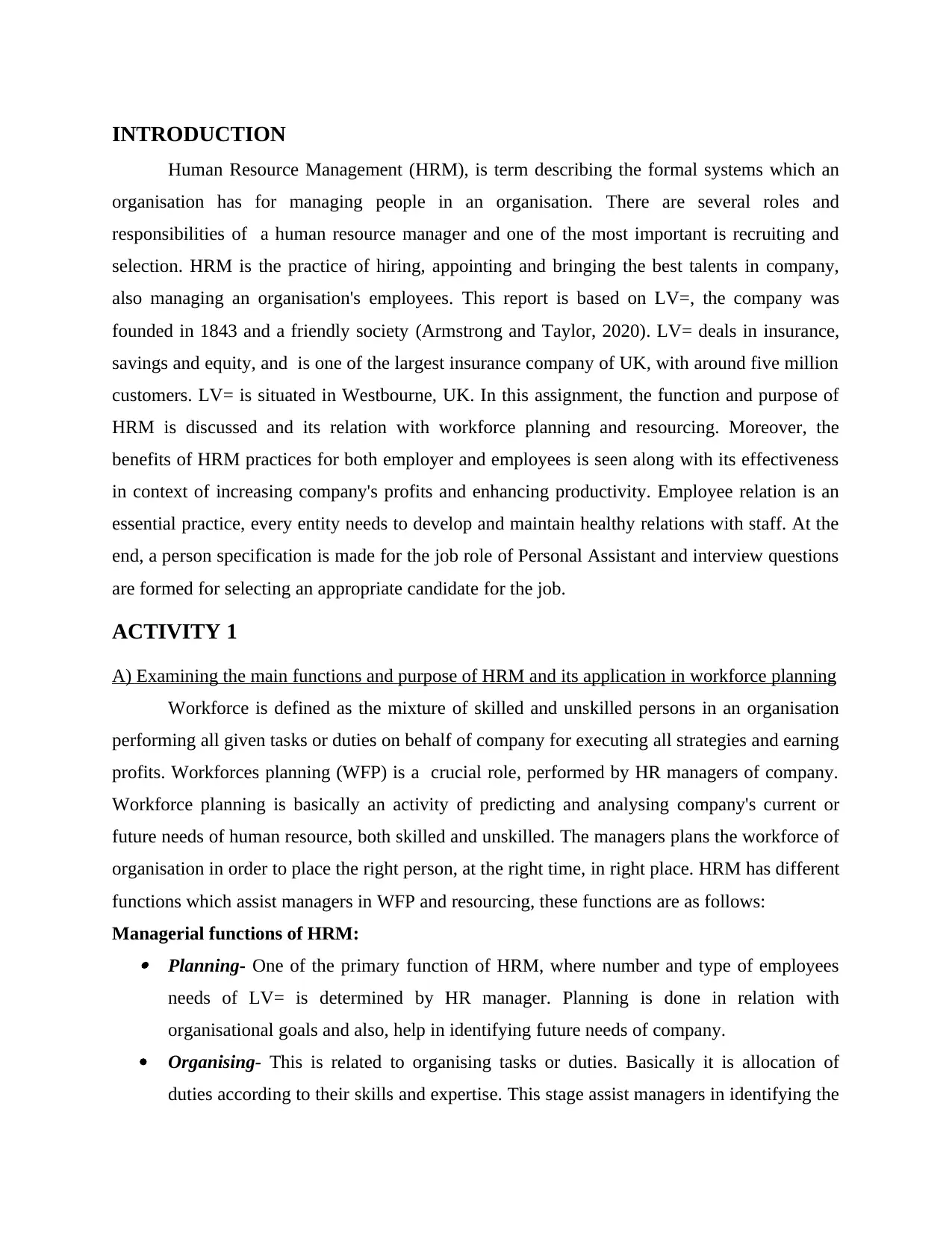
INTRODUCTION
Human Resource Management (HRM), is term describing the formal systems which an
organisation has for managing people in an organisation. There are several roles and
responsibilities of a human resource manager and one of the most important is recruiting and
selection. HRM is the practice of hiring, appointing and bringing the best talents in company,
also managing an organisation's employees. This report is based on LV=, the company was
founded in 1843 and a friendly society (Armstrong and Taylor, 2020). LV= deals in insurance,
savings and equity, and is one of the largest insurance company of UK, with around five million
customers. LV= is situated in Westbourne, UK. In this assignment, the function and purpose of
HRM is discussed and its relation with workforce planning and resourcing. Moreover, the
benefits of HRM practices for both employer and employees is seen along with its effectiveness
in context of increasing company's profits and enhancing productivity. Employee relation is an
essential practice, every entity needs to develop and maintain healthy relations with staff. At the
end, a person specification is made for the job role of Personal Assistant and interview questions
are formed for selecting an appropriate candidate for the job.
ACTIVITY 1
A) Examining the main functions and purpose of HRM and its application in workforce planning
Workforce is defined as the mixture of skilled and unskilled persons in an organisation
performing all given tasks or duties on behalf of company for executing all strategies and earning
profits. Workforces planning (WFP) is a crucial role, performed by HR managers of company.
Workforce planning is basically an activity of predicting and analysing company's current or
future needs of human resource, both skilled and unskilled. The managers plans the workforce of
organisation in order to place the right person, at the right time, in right place. HRM has different
functions which assist managers in WFP and resourcing, these functions are as follows:
Managerial functions of HRM: Planning- One of the primary function of HRM, where number and type of employees
needs of LV= is determined by HR manager. Planning is done in relation with
organisational goals and also, help in identifying future needs of company.
Organising- This is related to organising tasks or duties. Basically it is allocation of
duties according to their skills and expertise. This stage assist managers in identifying the
Human Resource Management (HRM), is term describing the formal systems which an
organisation has for managing people in an organisation. There are several roles and
responsibilities of a human resource manager and one of the most important is recruiting and
selection. HRM is the practice of hiring, appointing and bringing the best talents in company,
also managing an organisation's employees. This report is based on LV=, the company was
founded in 1843 and a friendly society (Armstrong and Taylor, 2020). LV= deals in insurance,
savings and equity, and is one of the largest insurance company of UK, with around five million
customers. LV= is situated in Westbourne, UK. In this assignment, the function and purpose of
HRM is discussed and its relation with workforce planning and resourcing. Moreover, the
benefits of HRM practices for both employer and employees is seen along with its effectiveness
in context of increasing company's profits and enhancing productivity. Employee relation is an
essential practice, every entity needs to develop and maintain healthy relations with staff. At the
end, a person specification is made for the job role of Personal Assistant and interview questions
are formed for selecting an appropriate candidate for the job.
ACTIVITY 1
A) Examining the main functions and purpose of HRM and its application in workforce planning
Workforce is defined as the mixture of skilled and unskilled persons in an organisation
performing all given tasks or duties on behalf of company for executing all strategies and earning
profits. Workforces planning (WFP) is a crucial role, performed by HR managers of company.
Workforce planning is basically an activity of predicting and analysing company's current or
future needs of human resource, both skilled and unskilled. The managers plans the workforce of
organisation in order to place the right person, at the right time, in right place. HRM has different
functions which assist managers in WFP and resourcing, these functions are as follows:
Managerial functions of HRM: Planning- One of the primary function of HRM, where number and type of employees
needs of LV= is determined by HR manager. Planning is done in relation with
organisational goals and also, help in identifying future needs of company.
Organising- This is related to organising tasks or duties. Basically it is allocation of
duties according to their skills and expertise. This stage assist managers in identifying the
⊘ This is a preview!⊘
Do you want full access?
Subscribe today to unlock all pages.

Trusted by 1+ million students worldwide

workforce expertise and allocating them jobs accordingly for attaining maximum
benefits.
Operative functions of HRM: Recruiting/ Hiring- This is a process of creating a pool of prospective candidates who
are suitable for the company and helps it in achieving all goals. This HRM functions
enables managers to bring the best workforce and resourcing LV= with efficient
employees (Bratton and Gold, 2017).
Performance appraisal- It is necessary that staff is performing their tasks well and it is
the function of HRM to analyse and check the performances of employees. Performance
appraisal function assist managers to seek knowledge about effectiveness of individuals
and accordingly training them for enhancing their skill set and ultimately benefiting
company.
Purpose of of HRM Training and Development- HRM has various functions which provides information
about employees or workforce and this data help managers to analyse the need of training
staff and updating their knowledge. Trainings are given to new comes for introducing
them to company and ongoing training is provided to existing staff for their development,
the main purpose of providing trainings to employees is to increase their skills set and
update their knowledge according to the current changing tends.
Employee relations- Another purpose of HRM is to maintain employee and labour
relations. This helps managers to resolve any disputes or conflicts arising in company
between personnels or in between workforce and top management.
B) Assessing functions of HRM in context of company
HRM is an effective process which is undertaken by managers to manage staff and
effectively run the company. HRM procedure has several functions which are discussed in above
section and assist in workforce planning and resourcing (Marler and Boudreau, 2017). Different
functions of HRM such as planning and organising, enables managers of LV= to known their
strengths and the areas in which the company lacks. Accordingly, search and recruit a pool of
potential candidates, which best fits with the company and contribute towards ultimate goals.
These functions of HRM allows LV= manager to know current personnels and their skills set,
according to which an entity can provide trainings to staff for enhancing their knowledge and
benefits.
Operative functions of HRM: Recruiting/ Hiring- This is a process of creating a pool of prospective candidates who
are suitable for the company and helps it in achieving all goals. This HRM functions
enables managers to bring the best workforce and resourcing LV= with efficient
employees (Bratton and Gold, 2017).
Performance appraisal- It is necessary that staff is performing their tasks well and it is
the function of HRM to analyse and check the performances of employees. Performance
appraisal function assist managers to seek knowledge about effectiveness of individuals
and accordingly training them for enhancing their skill set and ultimately benefiting
company.
Purpose of of HRM Training and Development- HRM has various functions which provides information
about employees or workforce and this data help managers to analyse the need of training
staff and updating their knowledge. Trainings are given to new comes for introducing
them to company and ongoing training is provided to existing staff for their development,
the main purpose of providing trainings to employees is to increase their skills set and
update their knowledge according to the current changing tends.
Employee relations- Another purpose of HRM is to maintain employee and labour
relations. This helps managers to resolve any disputes or conflicts arising in company
between personnels or in between workforce and top management.
B) Assessing functions of HRM in context of company
HRM is an effective process which is undertaken by managers to manage staff and
effectively run the company. HRM procedure has several functions which are discussed in above
section and assist in workforce planning and resourcing (Marler and Boudreau, 2017). Different
functions of HRM such as planning and organising, enables managers of LV= to known their
strengths and the areas in which the company lacks. Accordingly, search and recruit a pool of
potential candidates, which best fits with the company and contribute towards ultimate goals.
These functions of HRM allows LV= manager to know current personnels and their skills set,
according to which an entity can provide trainings to staff for enhancing their knowledge and
Paraphrase This Document
Need a fresh take? Get an instant paraphrase of this document with our AI Paraphraser
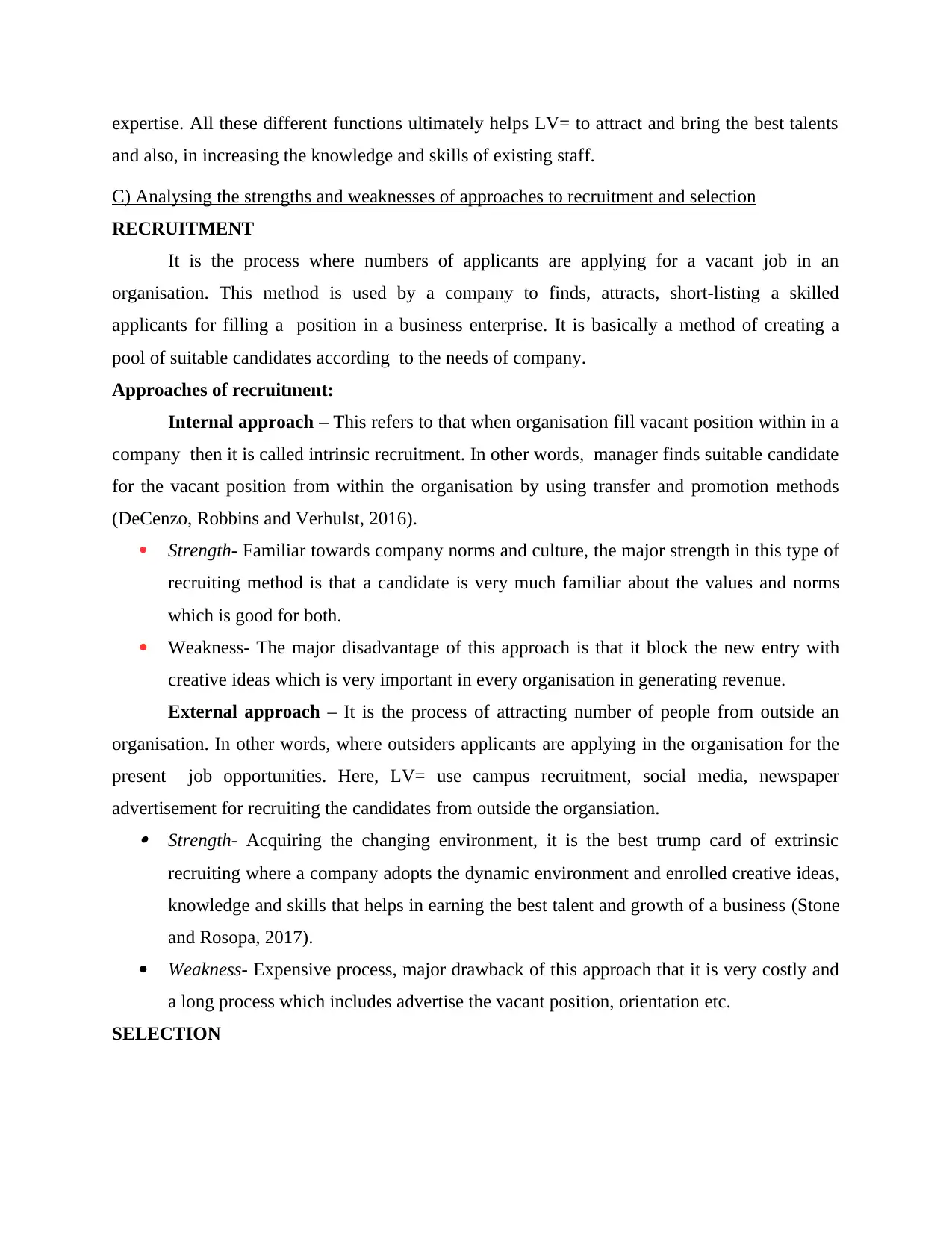
expertise. All these different functions ultimately helps LV= to attract and bring the best talents
and also, in increasing the knowledge and skills of existing staff.
C) Analysing the strengths and weaknesses of approaches to recruitment and selection
RECRUITMENT
It is the process where numbers of applicants are applying for a vacant job in an
organisation. This method is used by a company to finds, attracts, short-listing a skilled
applicants for filling a position in a business enterprise. It is basically a method of creating a
pool of suitable candidates according to the needs of company.
Approaches of recruitment:
Internal approach – This refers to that when organisation fill vacant position within in a
company then it is called intrinsic recruitment. In other words, manager finds suitable candidate
for the vacant position from within the organisation by using transfer and promotion methods
(DeCenzo, Robbins and Verhulst, 2016).
Strength- Familiar towards company norms and culture, the major strength in this type of
recruiting method is that a candidate is very much familiar about the values and norms
which is good for both.
Weakness- The major disadvantage of this approach is that it block the new entry with
creative ideas which is very important in every organisation in generating revenue.
External approach – It is the process of attracting number of people from outside an
organisation. In other words, where outsiders applicants are applying in the organisation for the
present job opportunities. Here, LV= use campus recruitment, social media, newspaper
advertisement for recruiting the candidates from outside the organsiation. Strength- Acquiring the changing environment, it is the best trump card of extrinsic
recruiting where a company adopts the dynamic environment and enrolled creative ideas,
knowledge and skills that helps in earning the best talent and growth of a business (Stone
and Rosopa, 2017).
Weakness- Expensive process, major drawback of this approach that it is very costly and
a long process which includes advertise the vacant position, orientation etc.
SELECTION
and also, in increasing the knowledge and skills of existing staff.
C) Analysing the strengths and weaknesses of approaches to recruitment and selection
RECRUITMENT
It is the process where numbers of applicants are applying for a vacant job in an
organisation. This method is used by a company to finds, attracts, short-listing a skilled
applicants for filling a position in a business enterprise. It is basically a method of creating a
pool of suitable candidates according to the needs of company.
Approaches of recruitment:
Internal approach – This refers to that when organisation fill vacant position within in a
company then it is called intrinsic recruitment. In other words, manager finds suitable candidate
for the vacant position from within the organisation by using transfer and promotion methods
(DeCenzo, Robbins and Verhulst, 2016).
Strength- Familiar towards company norms and culture, the major strength in this type of
recruiting method is that a candidate is very much familiar about the values and norms
which is good for both.
Weakness- The major disadvantage of this approach is that it block the new entry with
creative ideas which is very important in every organisation in generating revenue.
External approach – It is the process of attracting number of people from outside an
organisation. In other words, where outsiders applicants are applying in the organisation for the
present job opportunities. Here, LV= use campus recruitment, social media, newspaper
advertisement for recruiting the candidates from outside the organsiation. Strength- Acquiring the changing environment, it is the best trump card of extrinsic
recruiting where a company adopts the dynamic environment and enrolled creative ideas,
knowledge and skills that helps in earning the best talent and growth of a business (Stone
and Rosopa, 2017).
Weakness- Expensive process, major drawback of this approach that it is very costly and
a long process which includes advertise the vacant position, orientation etc.
SELECTION
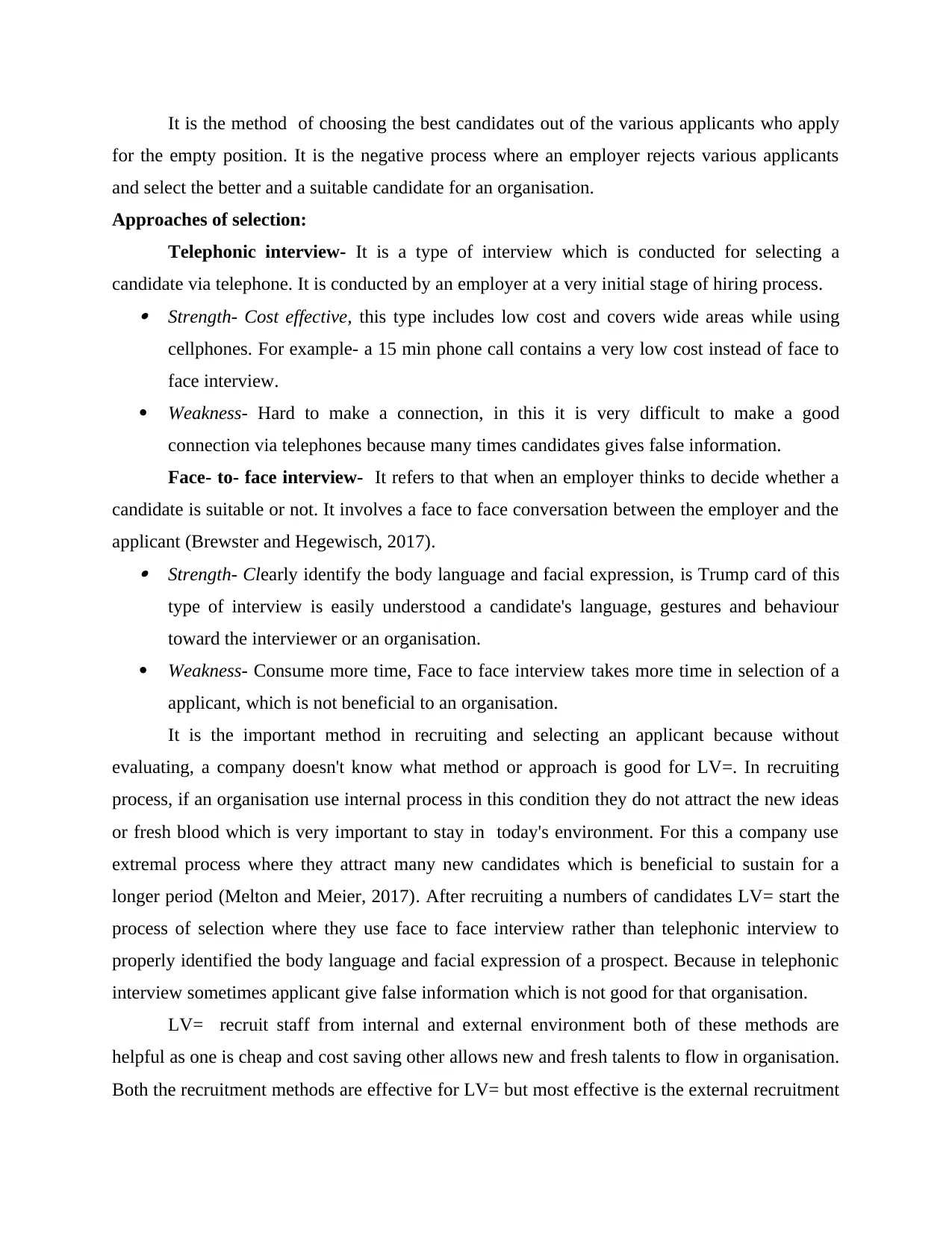
It is the method of choosing the best candidates out of the various applicants who apply
for the empty position. It is the negative process where an employer rejects various applicants
and select the better and a suitable candidate for an organisation.
Approaches of selection:
Telephonic interview- It is a type of interview which is conducted for selecting a
candidate via telephone. It is conducted by an employer at a very initial stage of hiring process. Strength- Cost effective, this type includes low cost and covers wide areas while using
cellphones. For example- a 15 min phone call contains a very low cost instead of face to
face interview.
Weakness- Hard to make a connection, in this it is very difficult to make a good
connection via telephones because many times candidates gives false information.
Face- to- face interview- It refers to that when an employer thinks to decide whether a
candidate is suitable or not. It involves a face to face conversation between the employer and the
applicant (Brewster and Hegewisch, 2017). Strength- Clearly identify the body language and facial expression, is Trump card of this
type of interview is easily understood a candidate's language, gestures and behaviour
toward the interviewer or an organisation.
Weakness- Consume more time, Face to face interview takes more time in selection of a
applicant, which is not beneficial to an organisation.
It is the important method in recruiting and selecting an applicant because without
evaluating, a company doesn't know what method or approach is good for LV=. In recruiting
process, if an organisation use internal process in this condition they do not attract the new ideas
or fresh blood which is very important to stay in today's environment. For this a company use
extremal process where they attract many new candidates which is beneficial to sustain for a
longer period (Melton and Meier, 2017). After recruiting a numbers of candidates LV= start the
process of selection where they use face to face interview rather than telephonic interview to
properly identified the body language and facial expression of a prospect. Because in telephonic
interview sometimes applicant give false information which is not good for that organisation.
LV= recruit staff from internal and external environment both of these methods are
helpful as one is cheap and cost saving other allows new and fresh talents to flow in organisation.
Both the recruitment methods are effective for LV= but most effective is the external recruitment
for the empty position. It is the negative process where an employer rejects various applicants
and select the better and a suitable candidate for an organisation.
Approaches of selection:
Telephonic interview- It is a type of interview which is conducted for selecting a
candidate via telephone. It is conducted by an employer at a very initial stage of hiring process. Strength- Cost effective, this type includes low cost and covers wide areas while using
cellphones. For example- a 15 min phone call contains a very low cost instead of face to
face interview.
Weakness- Hard to make a connection, in this it is very difficult to make a good
connection via telephones because many times candidates gives false information.
Face- to- face interview- It refers to that when an employer thinks to decide whether a
candidate is suitable or not. It involves a face to face conversation between the employer and the
applicant (Brewster and Hegewisch, 2017). Strength- Clearly identify the body language and facial expression, is Trump card of this
type of interview is easily understood a candidate's language, gestures and behaviour
toward the interviewer or an organisation.
Weakness- Consume more time, Face to face interview takes more time in selection of a
applicant, which is not beneficial to an organisation.
It is the important method in recruiting and selecting an applicant because without
evaluating, a company doesn't know what method or approach is good for LV=. In recruiting
process, if an organisation use internal process in this condition they do not attract the new ideas
or fresh blood which is very important to stay in today's environment. For this a company use
extremal process where they attract many new candidates which is beneficial to sustain for a
longer period (Melton and Meier, 2017). After recruiting a numbers of candidates LV= start the
process of selection where they use face to face interview rather than telephonic interview to
properly identified the body language and facial expression of a prospect. Because in telephonic
interview sometimes applicant give false information which is not good for that organisation.
LV= recruit staff from internal and external environment both of these methods are
helpful as one is cheap and cost saving other allows new and fresh talents to flow in organisation.
Both the recruitment methods are effective for LV= but most effective is the external recruitment
⊘ This is a preview!⊘
Do you want full access?
Subscribe today to unlock all pages.

Trusted by 1+ million students worldwide
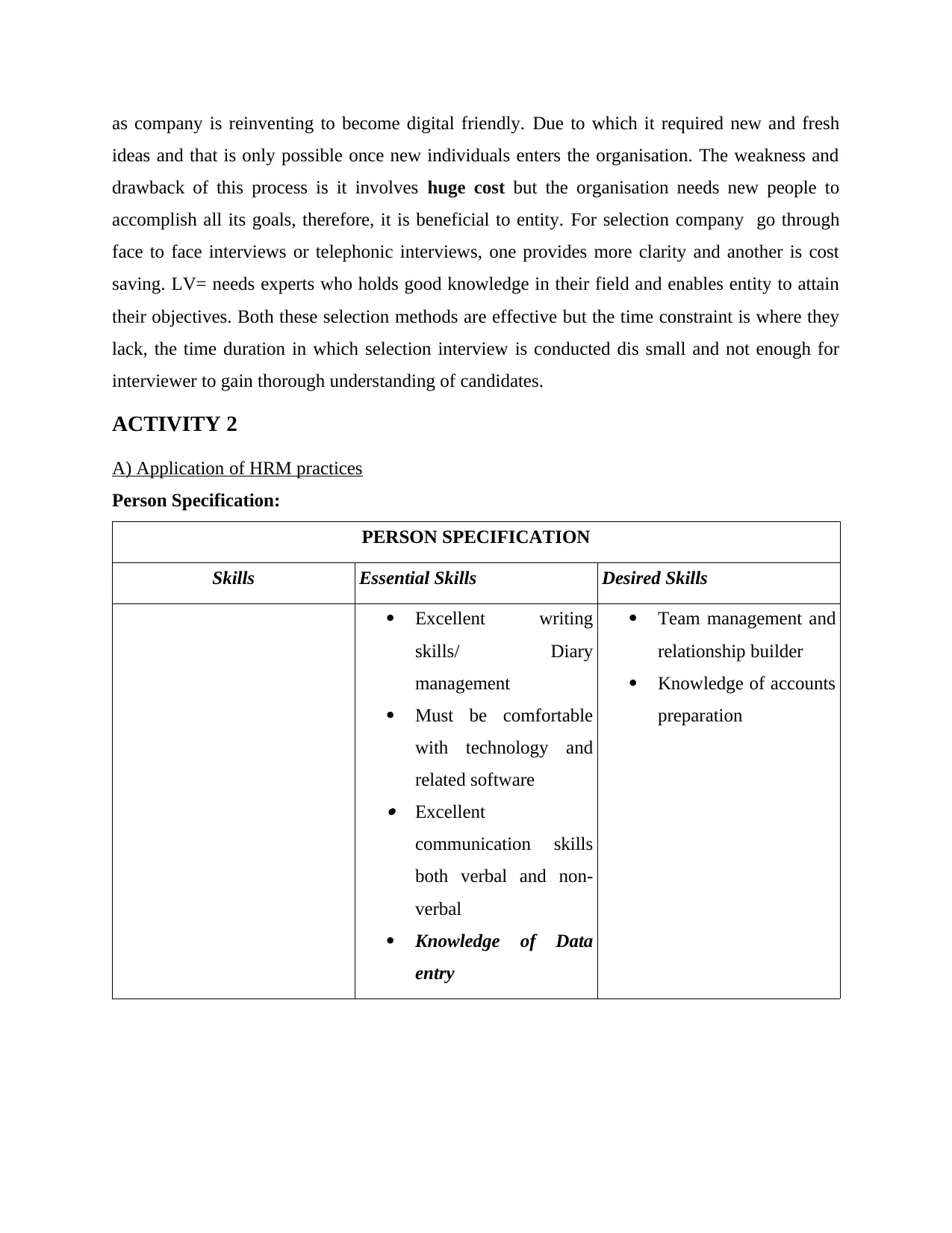
as company is reinventing to become digital friendly. Due to which it required new and fresh
ideas and that is only possible once new individuals enters the organisation. The weakness and
drawback of this process is it involves huge cost but the organisation needs new people to
accomplish all its goals, therefore, it is beneficial to entity. For selection company go through
face to face interviews or telephonic interviews, one provides more clarity and another is cost
saving. LV= needs experts who holds good knowledge in their field and enables entity to attain
their objectives. Both these selection methods are effective but the time constraint is where they
lack, the time duration in which selection interview is conducted dis small and not enough for
interviewer to gain thorough understanding of candidates.
ACTIVITY 2
A) Application of HRM practices
Person Specification:
PERSON SPECIFICATION
Skills Essential Skills Desired Skills
Excellent writing
skills/ Diary
management
Must be comfortable
with technology and
related software
Excellent
communication skills
both verbal and non-
verbal
Knowledge of Data
entry
Team management and
relationship builder
Knowledge of accounts
preparation
ideas and that is only possible once new individuals enters the organisation. The weakness and
drawback of this process is it involves huge cost but the organisation needs new people to
accomplish all its goals, therefore, it is beneficial to entity. For selection company go through
face to face interviews or telephonic interviews, one provides more clarity and another is cost
saving. LV= needs experts who holds good knowledge in their field and enables entity to attain
their objectives. Both these selection methods are effective but the time constraint is where they
lack, the time duration in which selection interview is conducted dis small and not enough for
interviewer to gain thorough understanding of candidates.
ACTIVITY 2
A) Application of HRM practices
Person Specification:
PERSON SPECIFICATION
Skills Essential Skills Desired Skills
Excellent writing
skills/ Diary
management
Must be comfortable
with technology and
related software
Excellent
communication skills
both verbal and non-
verbal
Knowledge of Data
entry
Team management and
relationship builder
Knowledge of accounts
preparation
Paraphrase This Document
Need a fresh take? Get an instant paraphrase of this document with our AI Paraphraser
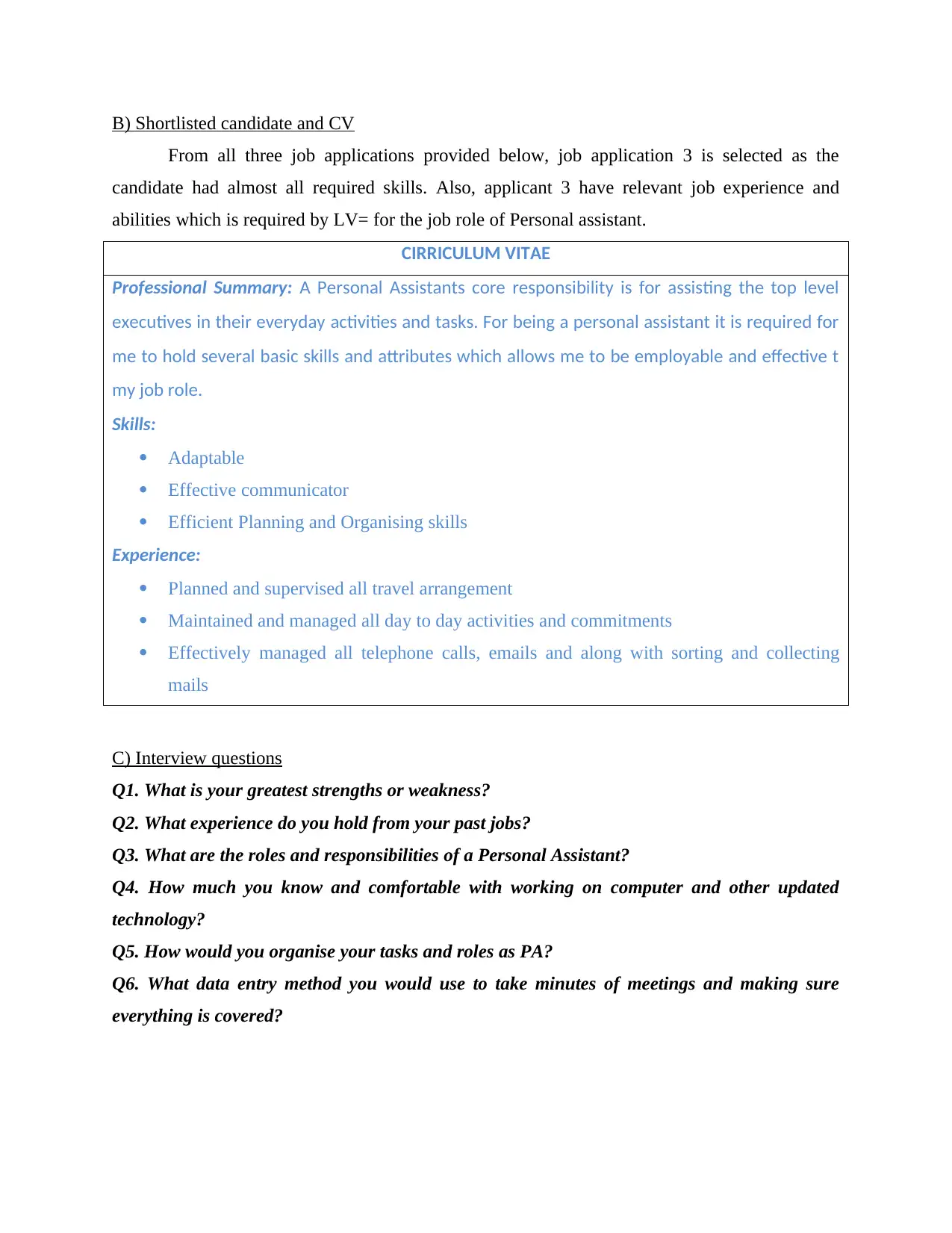
B) Shortlisted candidate and CV
From all three job applications provided below, job application 3 is selected as the
candidate had almost all required skills. Also, applicant 3 have relevant job experience and
abilities which is required by LV= for the job role of Personal assistant.
CIRRICULUM VITAE
Professional Summary: A Personal Assistants core responsibility is for assisting the top level
executives in their everyday activities and tasks. For being a personal assistant it is required for
me to hold several basic skills and attributes which allows me to be employable and effective t
my job role.
Skills:
Adaptable
Effective communicator
Efficient Planning and Organising skills
Experience:
Planned and supervised all travel arrangement
Maintained and managed all day to day activities and commitments
Effectively managed all telephone calls, emails and along with sorting and collecting
mails
C) Interview questions
Q1. What is your greatest strengths or weakness?
Q2. What experience do you hold from your past jobs?
Q3. What are the roles and responsibilities of a Personal Assistant?
Q4. How much you know and comfortable with working on computer and other updated
technology?
Q5. How would you organise your tasks and roles as PA?
Q6. What data entry method you would use to take minutes of meetings and making sure
everything is covered?
From all three job applications provided below, job application 3 is selected as the
candidate had almost all required skills. Also, applicant 3 have relevant job experience and
abilities which is required by LV= for the job role of Personal assistant.
CIRRICULUM VITAE
Professional Summary: A Personal Assistants core responsibility is for assisting the top level
executives in their everyday activities and tasks. For being a personal assistant it is required for
me to hold several basic skills and attributes which allows me to be employable and effective t
my job role.
Skills:
Adaptable
Effective communicator
Efficient Planning and Organising skills
Experience:
Planned and supervised all travel arrangement
Maintained and managed all day to day activities and commitments
Effectively managed all telephone calls, emails and along with sorting and collecting
mails
C) Interview questions
Q1. What is your greatest strengths or weakness?
Q2. What experience do you hold from your past jobs?
Q3. What are the roles and responsibilities of a Personal Assistant?
Q4. How much you know and comfortable with working on computer and other updated
technology?
Q5. How would you organise your tasks and roles as PA?
Q6. What data entry method you would use to take minutes of meetings and making sure
everything is covered?
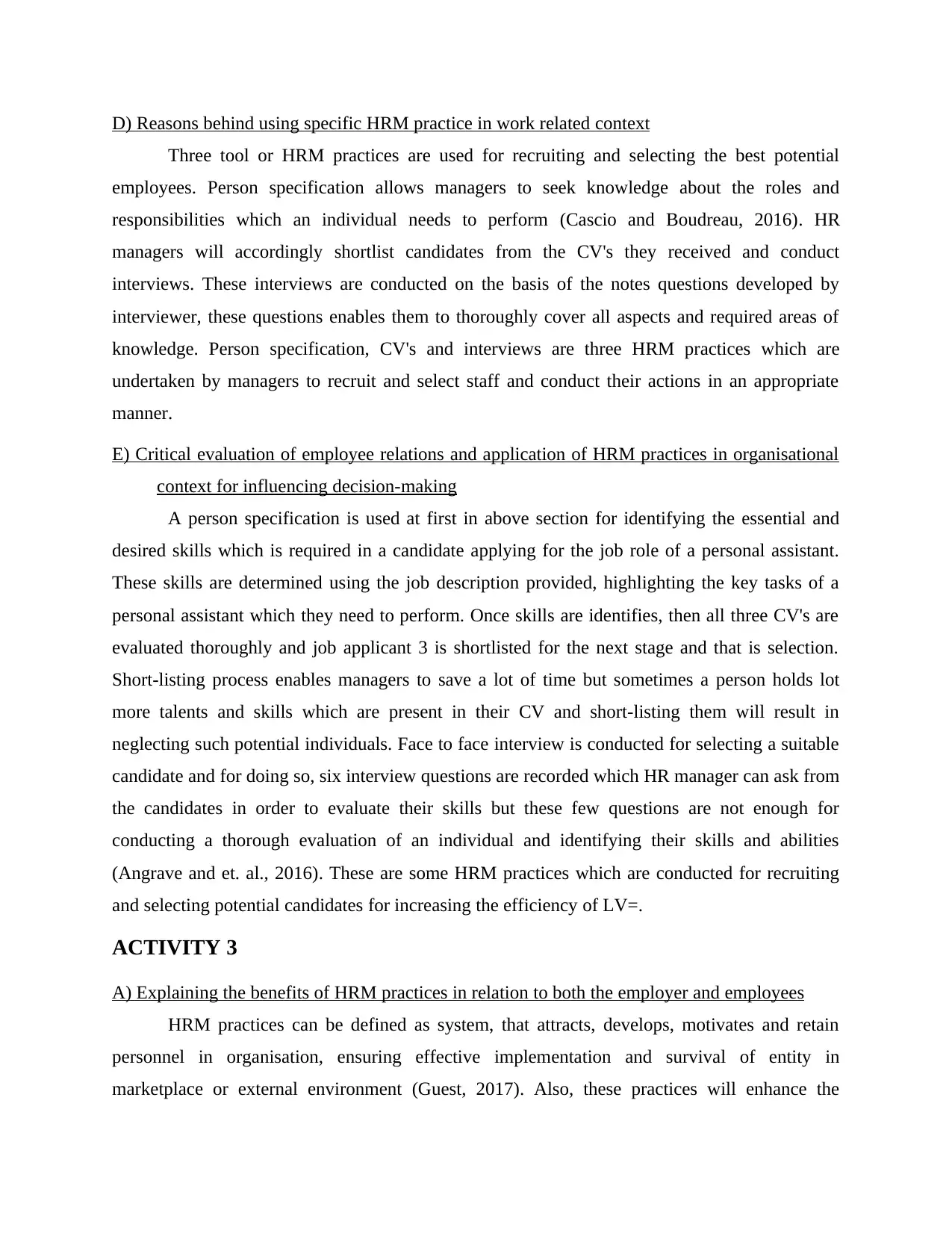
D) Reasons behind using specific HRM practice in work related context
Three tool or HRM practices are used for recruiting and selecting the best potential
employees. Person specification allows managers to seek knowledge about the roles and
responsibilities which an individual needs to perform (Cascio and Boudreau, 2016). HR
managers will accordingly shortlist candidates from the CV's they received and conduct
interviews. These interviews are conducted on the basis of the notes questions developed by
interviewer, these questions enables them to thoroughly cover all aspects and required areas of
knowledge. Person specification, CV's and interviews are three HRM practices which are
undertaken by managers to recruit and select staff and conduct their actions in an appropriate
manner.
E) Critical evaluation of employee relations and application of HRM practices in organisational
context for influencing decision-making
A person specification is used at first in above section for identifying the essential and
desired skills which is required in a candidate applying for the job role of a personal assistant.
These skills are determined using the job description provided, highlighting the key tasks of a
personal assistant which they need to perform. Once skills are identifies, then all three CV's are
evaluated thoroughly and job applicant 3 is shortlisted for the next stage and that is selection.
Short-listing process enables managers to save a lot of time but sometimes a person holds lot
more talents and skills which are present in their CV and short-listing them will result in
neglecting such potential individuals. Face to face interview is conducted for selecting a suitable
candidate and for doing so, six interview questions are recorded which HR manager can ask from
the candidates in order to evaluate their skills but these few questions are not enough for
conducting a thorough evaluation of an individual and identifying their skills and abilities
(Angrave and et. al., 2016). These are some HRM practices which are conducted for recruiting
and selecting potential candidates for increasing the efficiency of LV=.
ACTIVITY 3
A) Explaining the benefits of HRM practices in relation to both the employer and employees
HRM practices can be defined as system, that attracts, develops, motivates and retain
personnel in organisation, ensuring effective implementation and survival of entity in
marketplace or external environment (Guest, 2017). Also, these practices will enhance the
Three tool or HRM practices are used for recruiting and selecting the best potential
employees. Person specification allows managers to seek knowledge about the roles and
responsibilities which an individual needs to perform (Cascio and Boudreau, 2016). HR
managers will accordingly shortlist candidates from the CV's they received and conduct
interviews. These interviews are conducted on the basis of the notes questions developed by
interviewer, these questions enables them to thoroughly cover all aspects and required areas of
knowledge. Person specification, CV's and interviews are three HRM practices which are
undertaken by managers to recruit and select staff and conduct their actions in an appropriate
manner.
E) Critical evaluation of employee relations and application of HRM practices in organisational
context for influencing decision-making
A person specification is used at first in above section for identifying the essential and
desired skills which is required in a candidate applying for the job role of a personal assistant.
These skills are determined using the job description provided, highlighting the key tasks of a
personal assistant which they need to perform. Once skills are identifies, then all three CV's are
evaluated thoroughly and job applicant 3 is shortlisted for the next stage and that is selection.
Short-listing process enables managers to save a lot of time but sometimes a person holds lot
more talents and skills which are present in their CV and short-listing them will result in
neglecting such potential individuals. Face to face interview is conducted for selecting a suitable
candidate and for doing so, six interview questions are recorded which HR manager can ask from
the candidates in order to evaluate their skills but these few questions are not enough for
conducting a thorough evaluation of an individual and identifying their skills and abilities
(Angrave and et. al., 2016). These are some HRM practices which are conducted for recruiting
and selecting potential candidates for increasing the efficiency of LV=.
ACTIVITY 3
A) Explaining the benefits of HRM practices in relation to both the employer and employees
HRM practices can be defined as system, that attracts, develops, motivates and retain
personnel in organisation, ensuring effective implementation and survival of entity in
marketplace or external environment (Guest, 2017). Also, these practices will enhance the
⊘ This is a preview!⊘
Do you want full access?
Subscribe today to unlock all pages.

Trusted by 1+ million students worldwide
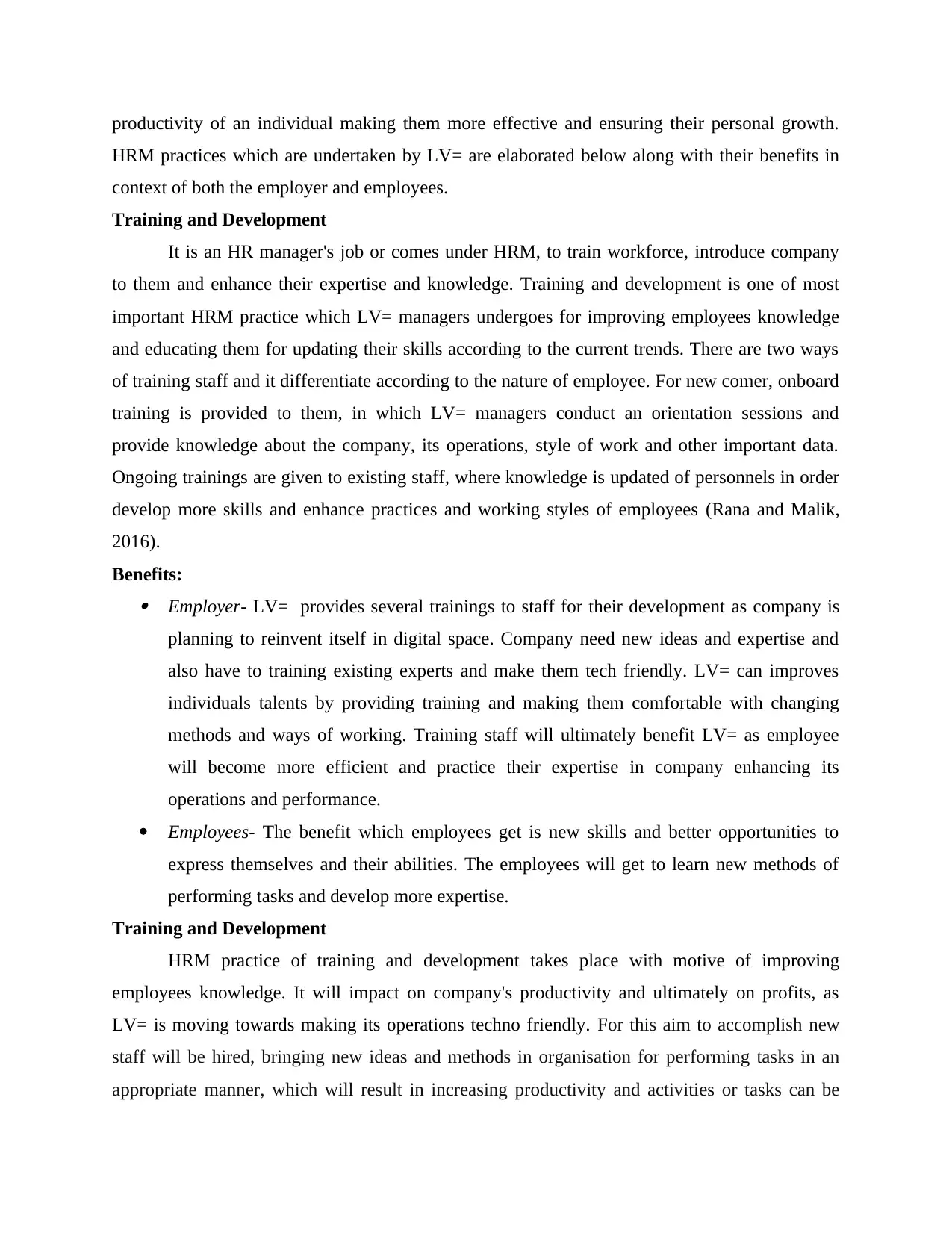
productivity of an individual making them more effective and ensuring their personal growth.
HRM practices which are undertaken by LV= are elaborated below along with their benefits in
context of both the employer and employees.
Training and Development
It is an HR manager's job or comes under HRM, to train workforce, introduce company
to them and enhance their expertise and knowledge. Training and development is one of most
important HRM practice which LV= managers undergoes for improving employees knowledge
and educating them for updating their skills according to the current trends. There are two ways
of training staff and it differentiate according to the nature of employee. For new comer, onboard
training is provided to them, in which LV= managers conduct an orientation sessions and
provide knowledge about the company, its operations, style of work and other important data.
Ongoing trainings are given to existing staff, where knowledge is updated of personnels in order
develop more skills and enhance practices and working styles of employees (Rana and Malik,
2016).
Benefits: Employer- LV= provides several trainings to staff for their development as company is
planning to reinvent itself in digital space. Company need new ideas and expertise and
also have to training existing experts and make them tech friendly. LV= can improves
individuals talents by providing training and making them comfortable with changing
methods and ways of working. Training staff will ultimately benefit LV= as employee
will become more efficient and practice their expertise in company enhancing its
operations and performance.
Employees- The benefit which employees get is new skills and better opportunities to
express themselves and their abilities. The employees will get to learn new methods of
performing tasks and develop more expertise.
Training and Development
HRM practice of training and development takes place with motive of improving
employees knowledge. It will impact on company's productivity and ultimately on profits, as
LV= is moving towards making its operations techno friendly. For this aim to accomplish new
staff will be hired, bringing new ideas and methods in organisation for performing tasks in an
appropriate manner, which will result in increasing productivity and activities or tasks can be
HRM practices which are undertaken by LV= are elaborated below along with their benefits in
context of both the employer and employees.
Training and Development
It is an HR manager's job or comes under HRM, to train workforce, introduce company
to them and enhance their expertise and knowledge. Training and development is one of most
important HRM practice which LV= managers undergoes for improving employees knowledge
and educating them for updating their skills according to the current trends. There are two ways
of training staff and it differentiate according to the nature of employee. For new comer, onboard
training is provided to them, in which LV= managers conduct an orientation sessions and
provide knowledge about the company, its operations, style of work and other important data.
Ongoing trainings are given to existing staff, where knowledge is updated of personnels in order
develop more skills and enhance practices and working styles of employees (Rana and Malik,
2016).
Benefits: Employer- LV= provides several trainings to staff for their development as company is
planning to reinvent itself in digital space. Company need new ideas and expertise and
also have to training existing experts and make them tech friendly. LV= can improves
individuals talents by providing training and making them comfortable with changing
methods and ways of working. Training staff will ultimately benefit LV= as employee
will become more efficient and practice their expertise in company enhancing its
operations and performance.
Employees- The benefit which employees get is new skills and better opportunities to
express themselves and their abilities. The employees will get to learn new methods of
performing tasks and develop more expertise.
Training and Development
HRM practice of training and development takes place with motive of improving
employees knowledge. It will impact on company's productivity and ultimately on profits, as
LV= is moving towards making its operations techno friendly. For this aim to accomplish new
staff will be hired, bringing new ideas and methods in organisation for performing tasks in an
appropriate manner, which will result in increasing productivity and activities or tasks can be
Paraphrase This Document
Need a fresh take? Get an instant paraphrase of this document with our AI Paraphraser
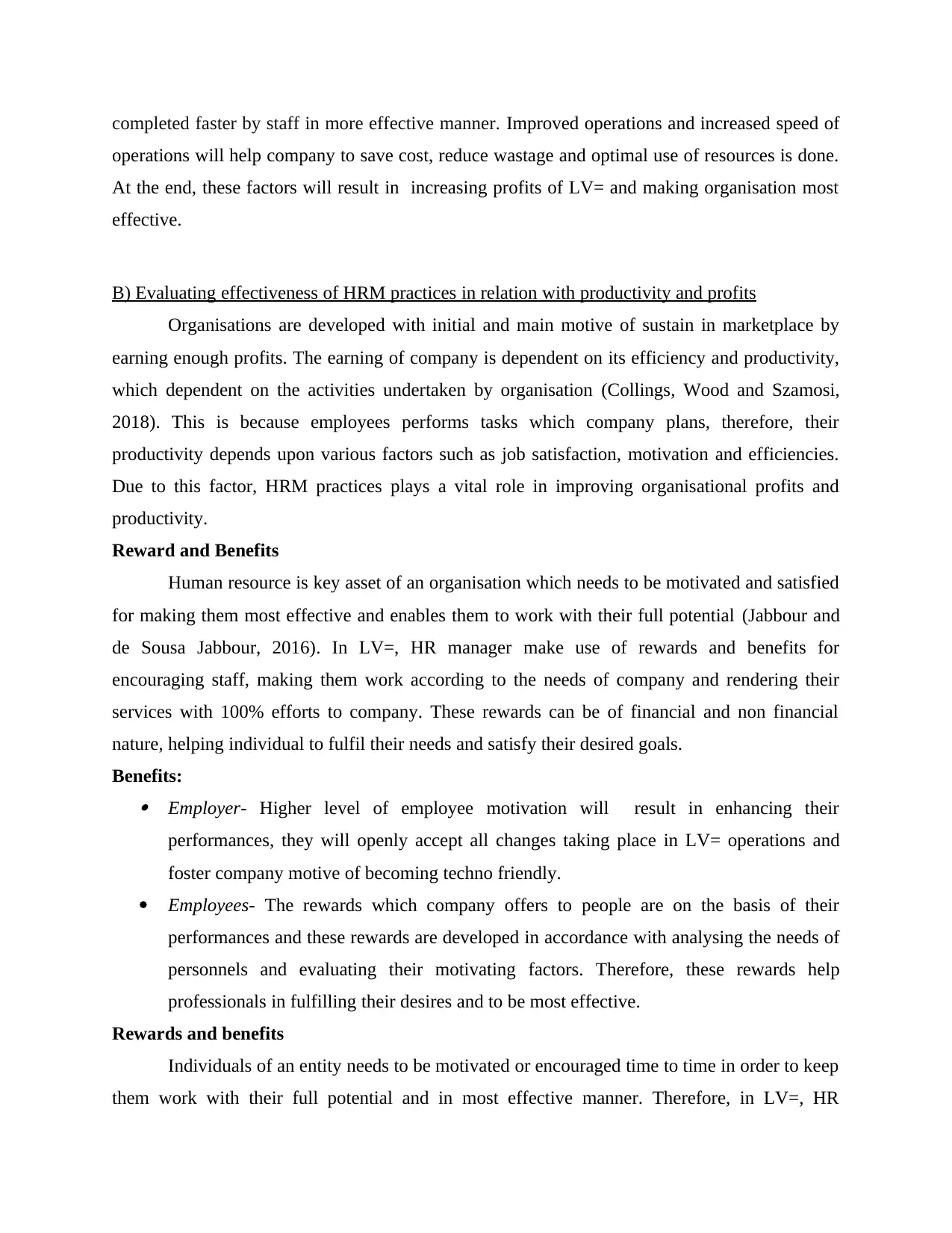
completed faster by staff in more effective manner. Improved operations and increased speed of
operations will help company to save cost, reduce wastage and optimal use of resources is done.
At the end, these factors will result in increasing profits of LV= and making organisation most
effective.
B) Evaluating effectiveness of HRM practices in relation with productivity and profits
Organisations are developed with initial and main motive of sustain in marketplace by
earning enough profits. The earning of company is dependent on its efficiency and productivity,
which dependent on the activities undertaken by organisation (Collings, Wood and Szamosi,
2018). This is because employees performs tasks which company plans, therefore, their
productivity depends upon various factors such as job satisfaction, motivation and efficiencies.
Due to this factor, HRM practices plays a vital role in improving organisational profits and
productivity.
Reward and Benefits
Human resource is key asset of an organisation which needs to be motivated and satisfied
for making them most effective and enables them to work with their full potential (Jabbour and
de Sousa Jabbour, 2016). In LV=, HR manager make use of rewards and benefits for
encouraging staff, making them work according to the needs of company and rendering their
services with 100% efforts to company. These rewards can be of financial and non financial
nature, helping individual to fulfil their needs and satisfy their desired goals.
Benefits: Employer- Higher level of employee motivation will result in enhancing their
performances, they will openly accept all changes taking place in LV= operations and
foster company motive of becoming techno friendly.
Employees- The rewards which company offers to people are on the basis of their
performances and these rewards are developed in accordance with analysing the needs of
personnels and evaluating their motivating factors. Therefore, these rewards help
professionals in fulfilling their desires and to be most effective.
Rewards and benefits
Individuals of an entity needs to be motivated or encouraged time to time in order to keep
them work with their full potential and in most effective manner. Therefore, in LV=, HR
operations will help company to save cost, reduce wastage and optimal use of resources is done.
At the end, these factors will result in increasing profits of LV= and making organisation most
effective.
B) Evaluating effectiveness of HRM practices in relation with productivity and profits
Organisations are developed with initial and main motive of sustain in marketplace by
earning enough profits. The earning of company is dependent on its efficiency and productivity,
which dependent on the activities undertaken by organisation (Collings, Wood and Szamosi,
2018). This is because employees performs tasks which company plans, therefore, their
productivity depends upon various factors such as job satisfaction, motivation and efficiencies.
Due to this factor, HRM practices plays a vital role in improving organisational profits and
productivity.
Reward and Benefits
Human resource is key asset of an organisation which needs to be motivated and satisfied
for making them most effective and enables them to work with their full potential (Jabbour and
de Sousa Jabbour, 2016). In LV=, HR manager make use of rewards and benefits for
encouraging staff, making them work according to the needs of company and rendering their
services with 100% efforts to company. These rewards can be of financial and non financial
nature, helping individual to fulfil their needs and satisfy their desired goals.
Benefits: Employer- Higher level of employee motivation will result in enhancing their
performances, they will openly accept all changes taking place in LV= operations and
foster company motive of becoming techno friendly.
Employees- The rewards which company offers to people are on the basis of their
performances and these rewards are developed in accordance with analysing the needs of
personnels and evaluating their motivating factors. Therefore, these rewards help
professionals in fulfilling their desires and to be most effective.
Rewards and benefits
Individuals of an entity needs to be motivated or encouraged time to time in order to keep
them work with their full potential and in most effective manner. Therefore, in LV=, HR
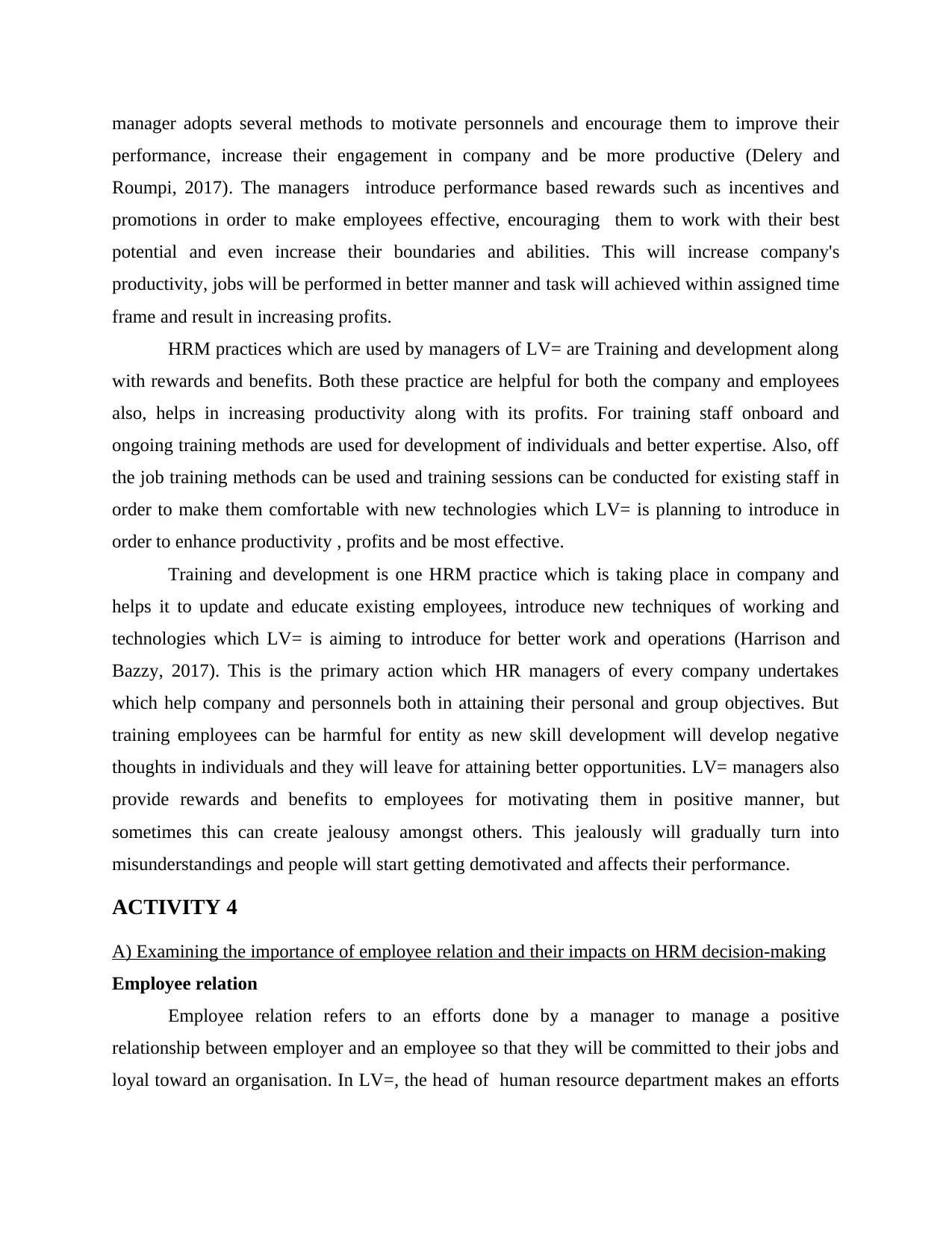
manager adopts several methods to motivate personnels and encourage them to improve their
performance, increase their engagement in company and be more productive (Delery and
Roumpi, 2017). The managers introduce performance based rewards such as incentives and
promotions in order to make employees effective, encouraging them to work with their best
potential and even increase their boundaries and abilities. This will increase company's
productivity, jobs will be performed in better manner and task will achieved within assigned time
frame and result in increasing profits.
HRM practices which are used by managers of LV= are Training and development along
with rewards and benefits. Both these practice are helpful for both the company and employees
also, helps in increasing productivity along with its profits. For training staff onboard and
ongoing training methods are used for development of individuals and better expertise. Also, off
the job training methods can be used and training sessions can be conducted for existing staff in
order to make them comfortable with new technologies which LV= is planning to introduce in
order to enhance productivity , profits and be most effective.
Training and development is one HRM practice which is taking place in company and
helps it to update and educate existing employees, introduce new techniques of working and
technologies which LV= is aiming to introduce for better work and operations (Harrison and
Bazzy, 2017). This is the primary action which HR managers of every company undertakes
which help company and personnels both in attaining their personal and group objectives. But
training employees can be harmful for entity as new skill development will develop negative
thoughts in individuals and they will leave for attaining better opportunities. LV= managers also
provide rewards and benefits to employees for motivating them in positive manner, but
sometimes this can create jealousy amongst others. This jealously will gradually turn into
misunderstandings and people will start getting demotivated and affects their performance.
ACTIVITY 4
A) Examining the importance of employee relation and their impacts on HRM decision-making
Employee relation
Employee relation refers to an efforts done by a manager to manage a positive
relationship between employer and an employee so that they will be committed to their jobs and
loyal toward an organisation. In LV=, the head of human resource department makes an efforts
performance, increase their engagement in company and be more productive (Delery and
Roumpi, 2017). The managers introduce performance based rewards such as incentives and
promotions in order to make employees effective, encouraging them to work with their best
potential and even increase their boundaries and abilities. This will increase company's
productivity, jobs will be performed in better manner and task will achieved within assigned time
frame and result in increasing profits.
HRM practices which are used by managers of LV= are Training and development along
with rewards and benefits. Both these practice are helpful for both the company and employees
also, helps in increasing productivity along with its profits. For training staff onboard and
ongoing training methods are used for development of individuals and better expertise. Also, off
the job training methods can be used and training sessions can be conducted for existing staff in
order to make them comfortable with new technologies which LV= is planning to introduce in
order to enhance productivity , profits and be most effective.
Training and development is one HRM practice which is taking place in company and
helps it to update and educate existing employees, introduce new techniques of working and
technologies which LV= is aiming to introduce for better work and operations (Harrison and
Bazzy, 2017). This is the primary action which HR managers of every company undertakes
which help company and personnels both in attaining their personal and group objectives. But
training employees can be harmful for entity as new skill development will develop negative
thoughts in individuals and they will leave for attaining better opportunities. LV= managers also
provide rewards and benefits to employees for motivating them in positive manner, but
sometimes this can create jealousy amongst others. This jealously will gradually turn into
misunderstandings and people will start getting demotivated and affects their performance.
ACTIVITY 4
A) Examining the importance of employee relation and their impacts on HRM decision-making
Employee relation
Employee relation refers to an efforts done by a manager to manage a positive
relationship between employer and an employee so that they will be committed to their jobs and
loyal toward an organisation. In LV=, the head of human resource department makes an efforts
⊘ This is a preview!⊘
Do you want full access?
Subscribe today to unlock all pages.

Trusted by 1+ million students worldwide
1 out of 17
Related Documents
Your All-in-One AI-Powered Toolkit for Academic Success.
+13062052269
info@desklib.com
Available 24*7 on WhatsApp / Email
![[object Object]](/_next/static/media/star-bottom.7253800d.svg)
Unlock your academic potential
Copyright © 2020–2025 A2Z Services. All Rights Reserved. Developed and managed by ZUCOL.





